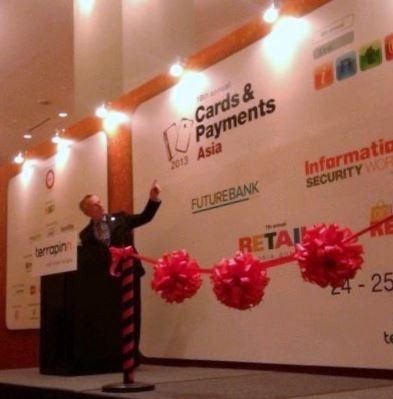
This week is Asia week, with a brief jaunt to open the Terrapinn Cards & Payments Summit in Singapore, followed by engaging in the Asian Banker’s Annual Summit in Jakarta.
I always enjoy visiting Asia as you gain unique insights you don’t see elsewhere. Over the past years, Asia is where I first saw NFC/RFID (Octopus, Hong Kong), mobile wallets (Edy from NTT DoCoMo, Japan), mobile banks (Jibun Bank and eBank, Japan), virtual currencies (QQ, China) and QR codes (Tesco, Korea).
There’s far more that Asia shows me, so this will be an exciting week.
The week starts with the honour of being asked to cut the ribbon to officially open the Exhibit Hall at Cards & Payments ...

... and what I note straight away is a focus upon RFID chips and M2M (Machine to Machine) transactions.
In other words, as transactions become embedded in everything from underpants to escalators (no relationship pun intended) through the placement of RFID chips inside everything, they will all be intelligently and wirelessly communicating with NFC readers built into phones and tablet
computers.
This is the core focus of the exhibit hall here and links into my focus upon the internet of things, where everything can transact with everything.
But then I realise I may have made a mistake.
By discounting NFC so readily in the past, with the expectation that it will be substituted by proximity payments (apps and GPS), I got it wrong.
Now I see why NFC can make a comeback, as it will provide the internet of things with the ability to transact.
Think about it.
I’ve been talking about chips in everything, so that they can wirelessly communicate.
Those chips in everything will be RFID chips today.
RFID can only hold a small amount of intelligence right now, so it needs something to receive the RFID information and that is NFC today.
Hence, NFC will become the reader mechanism in phones and other devices for RFID in the internet of things.
I guess the short-sightedness – or the mistake if you prefer – is thinking about NFC and RFID as it is today: a contactless system that requires contact.
Today, RFID and NFC is all about mass transit systems, cards and early generation systems.
I’m now thinking about it as it might be tomorrow and thinking: if I’m in a retail store and want to buy that shirt, jacket, tie or whatever, will I read the QR code or just want to hold my phone over its RFID tag?

I might do either or both, and it makes perfect sense to say that the RFID tag read by an NFC phone is workable.
So there are now two corners of debate: the NFC naysayers like PayPal, Apple and, until now, Chris Skinner, who believes the technology is past its sell-by date; and the NFC yaysayers like Samsung, Google and Brett King who think that RFID tags and stickers, and NFC phones and readers will be
an important part of our future.
Certainly, in the internet of things where everything can communicate and transact, we will need NFC and RFID … unless the internet of things is driven by the mobile internet of things where everything is geo-located and identified by the network.
It is this network-driven transaction system versus chip-driven transaction system that is the point.
The network-centric view, where everything is monitored real-time via the network, si the more sophisticated, intelligetnt and likely future scenario but the chip-based transaction system may well play an enabling short- to medium- term role in allowing the network to track the transactions.
Whatever the future reality, the fact that M2M is here and now is clearly here to stay.

Anyways, my comment about NFC and RFID being dead and substituted by GPS-based proximity payments went down well in Hall E, which was the Near Field Communication Hall at the Cards & Payments Summit 2013.
Whoops! (and yes, the RFID/NFC lobby did get to me)
I’ll provide a proper view on the whole proceedings at end of week after seeing what's cooking in Jakarta.
Chris M Skinner
Chris Skinner is best known as an independent commentator on the financial markets through his blog, TheFinanser.com, as author of the bestselling book Digital Bank, and Chair of the European networking forum the Financial Services Club. He has been voted one of the most influential people in banking by The Financial Brand (as well as one of the best blogs), a FinTech Titan (Next Bank), one of the Fintech Leaders you need to follow (City AM, Deluxe and Jax Finance), as well as one of the Top 40 most influential people in financial technology by the Wall Street Journal's Financial News. To learn more click here...

